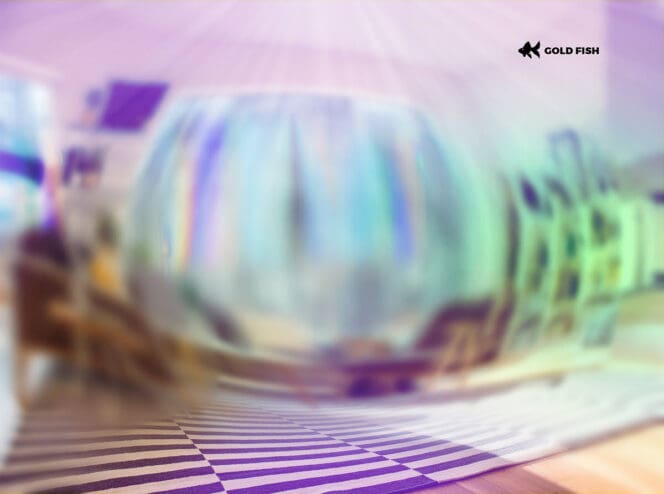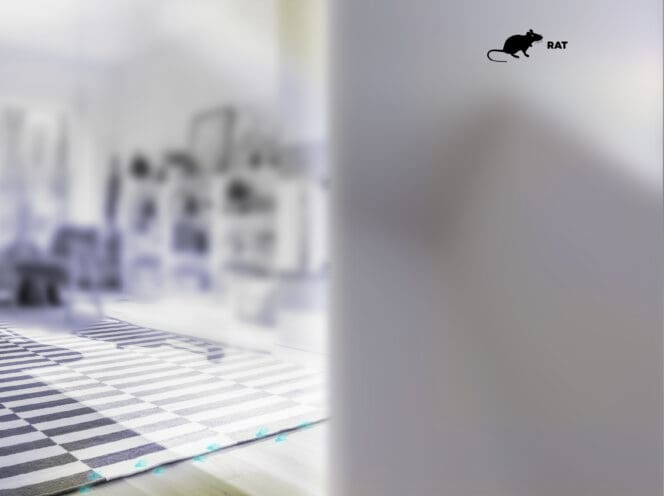Have you ever looked at your pet and wondered what could be going on in their head? While we may not be able to read the minds of animals, as eyesight experts, we can use scientific studies and decades of research to reveal how various animals are seeing the world.
To do this, we reviewed various studies which analyzed how animals focus, see color, perceive depth, and what other wonders they see with their eyes. We focused on the most common pets in America as well as the national bird: the bald eagle.
Take a look at how animals see the world below in our redesigned photos.

Dog

Man’s best friend’s eyesight performs best in low light, as during daylight hours, their vision is a little more washed out compared to humans, this is due to their nearsightedness, as well as their lack of true color vision.
The science of this is that humans have more (5%) cone photoreceptor cells, compared to dogs (3%), which are responsible for our vivid vision of colors. Dogs’ dichromatic vision means they see mainly violet-blue, yellow, and shades of grey – not black and white like many think. In terms of their field of view, dogs can see 240 degrees, that’s 40 degrees more than humans.
Cat

Similar to dogs, cats can see shades of blue and green and are very nearsighted, struggling with objects in the distance. Interestingly, a slow-moving object in the distance would likely appear like it was standing still to a cat due to their poor vision and as they are unable to change the shape of their eye lenses.
Cats see a similar width to humans, but they would have a slightly better peripheral vision allowing them to see prey and predators around them.
Goldfish

To experience the full 360 view of being a goldfish, please click here. You can use VR headsets for this or simply scroll around on your device.
Goldfish are designed to see things extremely close-up, for example, they could see something floating in the water they want to eat that would be incredibly difficult for a human to focus on.
Studies show that goldfish are incredibly receptive to refractions of light and this is how they navigate when swimming as the light reveals where objects and other animals are. In terms of colors, studies have replicated the goldfish eye and found they should be able to see all the colors humans can as well as ultraviolet light, meaning they can see waves of color that humans can’t.
Finally, goldfish can see almost a full 360 degrees around them, meaning they could see the full fishbowl in one view, however, it would be incredibly blurry, and a great challenge to distinguish detail.
Rat

Generally, rats have extremely poor vision and can see in blues and greens similar to dogs due to their reduction in cones in the retina. Their uniqueness however, is how they perceive the world around them as their eyes can work independently, meaning they could be looking at both the ceiling and floor simultaneously.
In our visualization, we’ve tried to imagine this exact scenario. While rats technically can see much wider than humans, their poor vision and double view mean they can’t fuze the images together as a humans’ eyes and brain would.
Housefly

To experience the full 360 imagining of what a housefly sees inside your home, please click here. You can use VR headsets for this or simply scroll around on your device.
In the movies, flies are often depicted as having a honeycomb-shaped vision made up of small hexagonal views, but in reality, it’s far more blurry, almost pixelated, as they have an extremely poor viewing distance. They can however see a full 360 degrees, but naturally, this isn’t much use unless they are extremely close to their subject.
Despite this, flies have the fastest visual responses out of all animals, it’s why they’re so good at getting away from threats. They would not be able to distinguish you as a person but they could see a large mass approaching slowly, allowing them to escape effectively. Recent studies show that flies may have the ability to process color in a similar way to humans, however, science does not currently allow us to know exactly the colors they can see. We do know that they can see polarized light, which is shown in the effect on the windows at the back.
Bald Eagle

While a bald eagle is an unlikely pet, it has been America’s national bird since 1782, and most importantly, its vision is fascinating.
Eagle’s can see things roughly 4-8 times further away than humans, the ideal mechanism for hunting small prey while soaring in the sky. As well as this, they can distinguish many more colors than humans, and the colors we do see would be far brighter to an eagle. Eagles are another animal that can see light ultraviolet light too, so in our visualization, the eagle has spotted the rat hiding behind the plant and can see a trail left from urine.
Animals and UV light
As we’ve discussed, some animals can see ultraviolet light, something humans typically cannot. Some people who have aphakia (missing a lens in one or both eyes) can see UV in some way, often reported as white-blue or white-violet light. For most people though, it would be like asking a blind person to describe a color they’ve simply never seen.
For many animals, it is key to their survival and day-to-day experience. This could mean an eagle could see the urine trail of an animal it is hunting, or a goldfish could use it to better ‘see’ when foraging for food. Where relevant, we have tried to visualize this in our imagery using the white-violet/heat imagery typically associated with UV, however, it could look entirely different to the animals themselves.
References
-
‘What do dogs (Canis familiaris) see? A review of vision in dogs and implications for cognition research’ (2017) (https://www.researchgate.net/publication/321089251_What_do_dogs_Canis_familiaris_see_A_review_of_vision_in_dogs_and_implications_for_cognition_research) Accessed February 2022
-
Kerry Ketring, a veterinarian with the All Animal Eye Clinic in Whitehall, Michigan, in Feline Vision: How Cats See the World (https://www.livescience.com/40459-what-do-cats-see.html) Accessed February 2022
-
‘Comprehensive optical design model of the goldfish eye and quantitative simulation of the consequences on the accommodation mechanism’ in Vision Research (2019) (https://www.sciencedirect.com/science/article/pii/S0042698918302402#b0075) Accessed February 2022
-
Excitatory and Inhibitory Vestibular Pathways to the Extraocular Motor Nuclei in Goldfish in Journal of Neurophysiology (https://journals.physiology.org/doi/full/10.1152/jn.1997.77.5.2765) Accessed February 2022
-
‘Rats have a double view of the world’ in Max Planck Institute for Biological Cybernetics in Tübingen (2013) (https://www.mpg.de/7269965/rats-overhead-binocular-field) Accessed February 2022
-
‘The Rat’s Eyes’ in Rat Behavior (http://www.ratbehavior.org/Eyes.htm) Accessed February 2022
-
‘Eagle Eyes’ in National Eagle Center (https://www.nationaleaglecenter.org/eagle-eyes/) Accessed February 2022
-
William Hodos, professor emeritus at the University of Maryland in ‘What If Humans Had Eagle Vision?’ (https://www.livescience.com/18658-humans-eagle-vision.html) Accessed February 2022
-
‘Visual Acuity and the Evolution of Signals’ in Trends in Ecology & Evolution (2018) (https://doi.org/10.1016/j.tree.2018.03.001) Accessed February 2022
-
Arizona State University, Ask a Biologist: ‘Do Insects Really See Hundreds of Tiny Identical Images?’ (https://askabiologist.asu.edu/content/bugvision-hollywood-misconception) Accessed February 2022
-
‘Fly eye mystery: Research provides insight into why flies have fastest vision in animal kingdom’ by University of Cambridge (https://phys.org/news/2012-10-eye-mystery-insight-flies-fastest.html)Accessed February 2022
-
‘Color vision in insects: insights from Drosophila’ in Journal of Comparative Physiology (https://link.springer.com/article/10.1007/s00359-019-01397-3) Accessed February 2022
Last Updated July 20, 2023
Note: This page should not serve as a substitute for professional medical advice from a doctor or specialist. Please review our about page for more information.